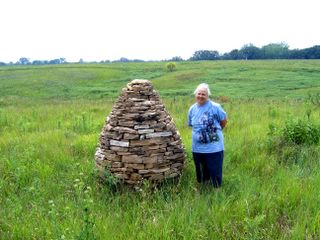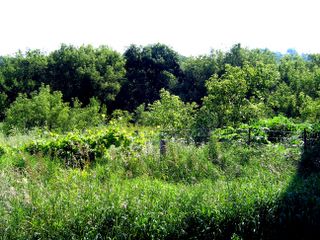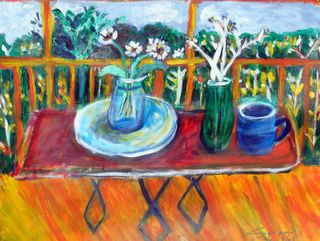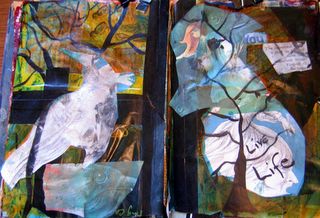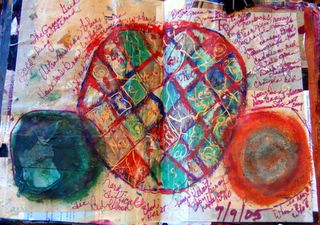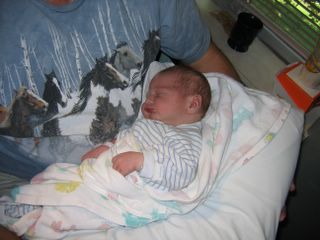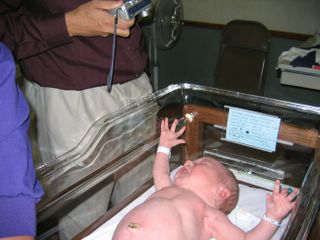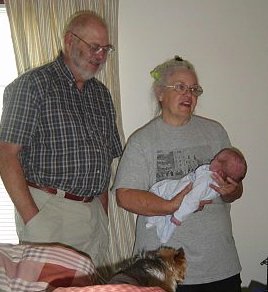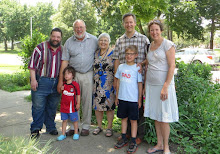Monday, August 29, 2005
Andy Goldsworthy Cairn near Grinnell, Iowa

This Cairn is part of a project by Andy Goldsworthy. It is on the Conard Environmental Research Area which is a part of the Prairie studies center at Grinnell College in Iowa.
From a review by Ann Wilson Lloyd in the New York Times: July 21, 2002
"Within singeing distance of a wind-whipped prairie fire in the spring, the Scottish artist Andy Goldsworthy huddled over camera and tripod, shooting frame after frame of his fieldstone sculpture. The pine-cone-shaped form, called a cairn, was engulfed by flame and smoke and left standing on stark, blackened ground. Afterward, he described — with glee, it seemed — how the camera had become hot enough to burn his fingers. Mr. Goldsworthy's cairn was built deliberately in the path of a prairie burn conducted by Grinnell College."
"Mr. Goldsworthy started the project in 2000 by building three smaller, temporary cairns. "I wanted the first layer of the project to develop the connections," he said. Built of local, uncut stones, the temporary cairns served as a way to mentally and physically sketch in the bigger project. The cairns on the coasts were built on beaches on Long Island Sound and at La Jolla, Calif. He worked during the three or so hours between tides, and then left the cairns to be destroyed by incoming waves. On the Iowa prairie, however, the temporary cairn remains, relatively unscathed by the prairie fire."
You can read more about the cairn project at: http://www.roxie.com/NYTSun.html

Thursday, August 25, 2005
Leading the Life O Riley
When I was in Wisconsin I stayed at the Life O Riley Farm and Guesthouse. What a great place to get away from everything and just relax! Mike and Jean are wonderful hosts and saw that I had plenty to eat, not just breakfast. Jean's bread and cinnamon rolls are too delicious for words. I also had fresh eggs, fresh dug potatoes and beets, all the berries I could pick and tender porkchops.
While I was there I worked on an ATC (artist trading card) project for a swap. I was doing collage with a lot of different papers and what a mess I had. I think Jean was afraid that I would not be able to get it all together before time to leave. But I did.
I loved listening all day to Wisconsin Public Radio's talk network. I must say I learned more interesting things from those broadcasts.
Life O Riley's webpage is: http://www.bbonline.com/wi/lifeoriley/index.html
While I was there I worked on an ATC (artist trading card) project for a swap. I was doing collage with a lot of different papers and what a mess I had. I think Jean was afraid that I would not be able to get it all together before time to leave. But I did.
I loved listening all day to Wisconsin Public Radio's talk network. I must say I learned more interesting things from those broadcasts.
Life O Riley's webpage is: http://www.bbonline.com/wi/lifeoriley/index.html
Mandala Journal page
The assignment was to draw a mandala on two pages. Then list all the colors in your mandala. Finally we were to write about each color and what it meant to the artist for at least 10 minutes.
Tuesday, August 16, 2005
A workshop with Juliana Coles
I drove up to Southwest Wisconsin to take an altered book workshop with Juliana Coles. The class was called : Reconstruction Era: Rebuilding the Self through Shadow
You can see pictures from our workshop at http://www.valleyridgeartstudio.com/albums/070905/index.html
and learn more about Valley Ridge Studio at http://www.valleyridgeartstudio.com/
You can see pictures from our workshop at http://www.valleyridgeartstudio.com/albums/070905/index.html
and learn more about Valley Ridge Studio at http://www.valleyridgeartstudio.com/
The Sex Life of Corn
One of the things I learned this summer was about the sex life of corn. Eric and Guinnie's farm is surrounded by seed corn fields. They are farmed by different people, but most of the corn goes to Monsanto for seed. I learned about corn de tasseling on ideabox.debatenation.com/
Corn detasseling is the crucial last step in producing hybrid corn seed. It involves removing the pollen-producing top part of the plant, the tassel, so the corn can't pollinate itself. Instead, pollen from another variety of corn grown in the same field is carried by the wind, pollinating the detasseled corn. The result is corn that bears the genetic characteristics of both varieties and can produce healthier crops with higher yields. Despite technological advances in agriculture, detasseling is still a task that for the most part is done by hand.The detasseling season lasts only about 20 days beginning in mid-July and, because it's usually minimum-wage work, it doesn't attract many migrant workers. But teenagers are drawn to the fast cash they can make, sometimes $4,000 a season. About 100,000 teenagers in the U.S. do this work each summer, according to estimates by seed companies and detasseling contractors.
Learn more at http://www.teamcorn.com/aboutdetasseling.shtml
Corn detasseling is the crucial last step in producing hybrid corn seed. It involves removing the pollen-producing top part of the plant, the tassel, so the corn can't pollinate itself. Instead, pollen from another variety of corn grown in the same field is carried by the wind, pollinating the detasseled corn. The result is corn that bears the genetic characteristics of both varieties and can produce healthier crops with higher yields. Despite technological advances in agriculture, detasseling is still a task that for the most part is done by hand.The detasseling season lasts only about 20 days beginning in mid-July and, because it's usually minimum-wage work, it doesn't attract many migrant workers. But teenagers are drawn to the fast cash they can make, sometimes $4,000 a season. About 100,000 teenagers in the U.S. do this work each summer, according to estimates by seed companies and detasseling contractors.
Learn more at http://www.teamcorn.com/aboutdetasseling.shtml
What I did this summer
Here I am back again after a long absence. I can't wait to tell you what all I did this summer, but first ......as they say on tv..... The big news is that I am now Oma for real.
Miles Wallace McIntyre was born on August 4, 2005. He weighed in at 9 lbs. 11 oz. and is 21 1/2 inches tall. Both of his parents are tall so he is bound to be a big guy. His father, Eric says he is going to be a line backer. Everyone is doing well and the sleepless nights will pass soon. (everyone hopes)
Miles Wallace McIntyre was born on August 4, 2005. He weighed in at 9 lbs. 11 oz. and is 21 1/2 inches tall. Both of his parents are tall so he is bound to be a big guy. His father, Eric says he is going to be a line backer. Everyone is doing well and the sleepless nights will pass soon. (everyone hopes)

